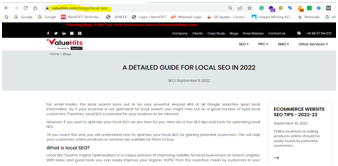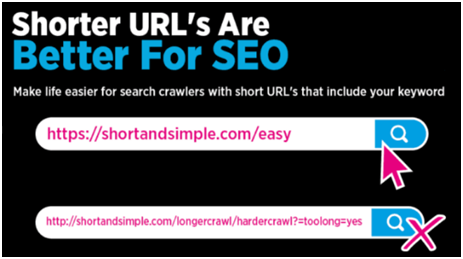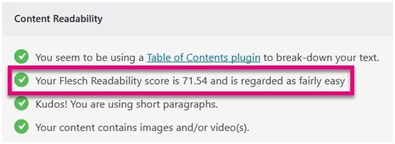On-Page SEO Checklist 2023-24 to Get Ranked on SERPs
Our latest On-Page SEO Checklist will help you increase your website ranking on search engines. This process can take time and needs patience and consistency to get the desired outcome. If you do not know where to start, here is a checklist for you.
All the key factors mentioned will either:
- Directly impact the pages on the desired website
- Impact a factor that affects your web pages
If something is left out, this means it is as not actionable
During the final words of this on-page SEO checklist, you will find the five most essential on-page factors to rank your websites high in the search results.
In case you require help with any other parts of SEO, we are for you with the full SEO checklist and link-building checklist for downloading!
Below are the 27-page ranking keys you need to carefully read for on-page SEO tasks in 2023-24.
On-Page SEO Checklist
Let’s begin the on-page SEO checklist to improve your Website.
- Your Main Keyword at The Beginning of the Title Tag
Inserting your primary target keyword at the start of your title h1 tag helps you attain benefits in the search engines:

It is one of the major and essential on-page factors.
Why do you ask?
Optimizing title tags allow search engines to recognize what the main topic is on the website; it happens within milliseconds after scanning your page.
If you have doubts regarding the best page title for your target audience, you can use Yoast to set title tags for your target readers and search engines to get the best results. Therefore, make sure this element is part of your marketing strategy.
- Add a primary keyword in the URL
A roundtable session of Google in 2016 stated that adding your primary keyword in your URL helps your website rank.
However, it is considered a very small factor in ranking the website. I would say to add this is the best SEO practice for adding your primary keyword to all the page URLs from now onwards.
Here is one example:

Remember that every little thing helps when you desire to get on the top. That is why it is a part of this SEO checklist.
- Your Page Title In H1 Tags
“<H1>” tags guarantees that your keyword containing the title is crawled efficiently by Google.
Google crawlers look for the keywords in the HTML.
When the title is not inside these tags, it can get overlooked by the search engine.
Surely, you don’t want this to occur.
WordPress website can help you with this, but check if your theme is compatible enough. If you use some other platform, you will have to do this manually on each webpage.
To format this tag:

You need to add it in your blog posts code editing area and put the “<H1>” heading tags.
It should look like this:

- Length Of URL
The shorter and crisp your content URL structure, the more it is suitable for the search engine.
Because this helps the search engine crawlers. Short URL length helps because:
- It adds clarity to your page
- It needs less time to crawl on your complete site map

You will also be an advantage to your users as it will be easy to remember.
We advise you to get the best permalink structure.
- User Experience-Focused Content Structure
Being a part of content strategy, your website content must focus on the user experience. In fact, in today’s time with new Google page experience updates.
It means your blog’s layout and formatting must allow the user to effortlessly navigate their way through your content to search for the right answers to their questions.
Factors that majorly impact user experience are:
- Clear headings and subheadings
- Visuals such as images
- Keeping the body of content into paragraphs
- Using bullet points and text boxes
You must then focus on generating a layout for your content that can be easily navigated. Your page structure must help the users to find their answers as rapidly as possible.
You need to follow as per below points:
- Lots of white space
- Reader-friendly headings
- Bullet points
- Images
- Links
This will make sure the content is easy on the eye and easy for a reader to work their way through.
Your user’s experience is the main focus of on-page SEO.
- Target Keyword In Your Meta Description
The Meta description tag is the element that Google pays special attention to.
Optimizing Meta descriptions will help to:
- Give a true overview of your page content
- Add your primary keyword
This will help to boost the ranking of your pages.
Therefore, focus on the meta descriptions and make sure the primary keyword is optimized!
Note: You can try using structured data schema markup for your result to stand out.
Indeed, structured data will give you proper results with more information, such as star rating, pricing, stock availability, and review stars.
- Unique Content
Search engines constantly keep working to avoid duplication of the content. It assures that the same content cannot rank for the same main keyword twice.
If it detects that the content is duplicated on several other sites then only one of those pages will rank and it is impossible to predict which page will rank. You need to keep your content unique as much as possible to avert keyword cannibalization and other SEO issues.
As Rand Fishkin said, it shouldn’t just be unique… It should add unique value.
For instance, if your content is about how to cook rice, then it must contain a unique way to cook rice, different from other blog websites or content.
Search engines keep searching for new and unique content all the time.
- Add Primary Keyword In the First 50 to 100 Words
From the SEO perspective, the sooner your target keyword appears in your content, the immediate search engine crawlers can understand what your content is about.

Several SEOs and writers forget that they have to add the main keyword at the end of the introduction or after their blog post.
Therefore, always check before you publish any blog content. If the keyword is within 50 to 100 words, maintain the same frequency for every page of your website.
- Content Reading Level
Before, Google used to tag the content based on the reading level like:
- Basic
- Intermediate
- Advanced
As per copywriting, a lower reading level as close to a basic level is advised for most websites. It makes sure that the content is easily accessible to the most number of users. However, depending on the niche, this can keep changing.
For instance, a research paper or a science journal website would require a higher reading level than other websites. The same logic applies to a broadsheet newspaper and a tabloid newspaper.
However, this option was removed later, which does mean that Google ignored it.
Tips- You might use Rank Math: the best SEO plugin for WordPress, or Yoast SEO plugins to get your reading level:

Regardless of the ranking, the factor – reading level is an essential deciding factor that can impact the ranking of your pages.
- Subheadings In H2 Tags
The subheadings must have header tags; it allows search engines to get a clear image of your page and the sub-topics that you have written about.

This factor acts as a structure to your web page for search engines and it is also loved by all the visitors.
- Synonym Rich Content
Websites can rank the main keywords that are not even added to the web pages.
This is a by-product of “Semantic Search”
This is where a page ranks as per the synonym of the main subject of the page.
This frequently happens with topics that are closely associated with each other or which possess different dialects.
For instance…
Digital Marketing Company and “Digital Marketing Agency” are words that mean the same. But Google could choose to rank a particular content focused on a Company to also rank for Agency terms.

Doing keywords research and finding main keywords with a possible keyword difficulty and appropriate search volume that you optimize for the synonyms that help you attain more organic traffic with the help of multiple keyword research.
- LSI Keywords In Content
LSI Keywords help to give the contexts of your content, which means the context of the words and phrases in your content.
There is a lot of debate about whether these keywords are useful or not but we insist to keep this factor in mind.
For example, say you are targeting “Podcast Microphones”. Your LSI keyword phrases might be:
- Best podcast microphone
- Podcast microphone setup
- Cheap podcast microphone
- The Blue Yeti microphone
A dash of these LSI keyword changes in your content will make it more relevant to the visitors.
This may also increase the website traffic from other related keywords.
- Use Of Outbound Links
High-quality outbound links can help search engines determine the complete value of your content.
The citations, quotes, and external links at the end of the research articles and case studies regarding the topic you are discussing help add authorization to your page and show you are trying to add value.
Make sure you use an appropriate anchor text and focus on the dofollow and nofollow tag.
Note: Place superior-quality links to reliable authority sites in your niche.
- Keyword Order
The specific order of a keyword being searched for and where it appears on your page impacts the ranking of the website.
People frequently use changes of a search term; however, they have the same user intent.
So it is vital to cover your bases.
Here is an example:
Few people are trying to purchase a book – Tribe of Mentors by Tim Ferriss. If four people search for it, they will use the primary keyword in these four formats:
- Tribe of mentors timferriss
- Tim ferriss tribe of mentors
- Tribe of mentors by timferriss
- Tim ferriss tribe mentors
Despite the use of different keywords, they are looking for the same thing.
This order of words can impact where you show up in search engine rankings. Particularly; in a highly competitive niche.
To overcome this, you can use a mix of keywords with a good keyword density in your entire content for maximizing the reach of your optimized page.
- Internal Linking
Building internal links is the most underrated strategy in SEO, but one must pay attention to this skill.
Internal links are links from one page to another significant website. Therefore, you must use a range of anchor text.
When we talked about how keywords signal search intent; therefore, it made sense to link to my types of keywords page.
Internal link building puts an extra value on the reader because it gives them the resource for reading.

But it has more use.
It helps make the website much easier for crawlers by giving an access point to another web page.
- Optimised Image Alt Tags
Images are not used only for web design; alt tags help Google to interpret the images present on your webpages.
As image crawlers cannot recognize every picture with 100% accuracy, it is better to help it recognize by adding an alt text tag for all your images.
Take the example of below image:

Several website image uploaders would display this image message as a default alt tag like:
But this is also difficult for the search engine crawlers to analyze.
Instead, it is best to use descriptive alt text for the web crawlers.
- My workspace
- MacBook and coffee cup
- Old wooden table with a modern laptop
You can easily get the picture.
Such tags and file names can have the target keywords to help add relevance to your webpage.
Make sure you use them throughout your page but do not stuff the target keywords.
- Working Links
Make sure that all the external & internal links on your website pages are working and do not result in 404 pages.
Not only does this waste link importance, but it also severely damages the user experience, which knock-on the effect on other strategies.
- Mobile Responsive Website
In 2015 Google started penalizing websites that do not fit mobile UI.
It means if your website is suitable for the mobile device to view then it will not rank on search engines.
It is essential to generate traffic. It was later compounded by the rollout of mobile-first indexing in 2018.
- HTTPS Security
A few years back, in 2014, Google broadcasted that websites with HTTPS encryption will be prioritized.
Also, this signal will get stronger over the passing time.
Sill your website is not HTTPS; now is the right time to switch it.
- Fast Site Speed
When it is about on-page SEO, the page speed counts as it matters. In 2010 Google said it would rank the website based on its speed.
A slow website can affect your ranking as well as extra money in the long term.
Therefore, this is a factor you should take seriously because it is completely in your control as it usually boosts your website’s speed within a few hours.
Check the Nitropack review and case study to understand how to fix all of your website speed issues.
- Length Of Dwell Time
Dwell Time is the total time spent on your page consuming the content offered after finding your page in the search results.
For example, I want to check the Google search results for “How to cook Khichdi”.
Several results will pop up on my screen, but naturally, I will select the top result by the search engine.
What will happen when I land on that particular page is one of three potential outcomes:
- I’ll leave immediately: I will take a glance at the content and think, “Nah, not for me”
- I’ll spend a few minutes there: I may read the content and think, “Okay, this is helpful”
- I will spend a long time: I will read the page content and thinking, “Yes! This is perfect”
It helps the search engines a lot to determine the quality of the content.
If a high number of people leave promptly, it will be tagged as poor content.
If people dwell for a few minutes it will be tagged as average.
And if people spend a long time there it will be tagged as excellent.
You can improve your dwell time by boosting the quality of content and using different SEO copywriting techniques in your writing.
- Length Of Content
Long-form content frequently outperforms, and only short-form content has a higher chance of getting ranked.
It was found that an average blog post length that got ranked first on pages had 1,890 words.
However, there is not a set rule for content length, and the content length can keep changing as per the niches.
- Bounce Rate
As per Google that bounce rate never affects the ratings.
But Moz has presented some interesting data to show that it correlates with higher rankings.
If you are not aware of what the bounce rate is, then understand that it is the count of how many people come to your page and left before landing on another webpage.
Make sure you aim for long and in-depth content.
- Depth Of Content
Depth of content means the content body should not be thin.
While your content has to be long, it should also have depth concerning the relevance of information that answers people’s questions.
For example, there are two blogs regarding cooking Khichdi. The first shows:
- Step #1:Boil water
- Step #2:Put rice in water
- Step #3:Wait till the rice is soft
- Step #4:Eat rice
Whereas the second one says:
- Step #1:Boil the water and add two pinches of salt
- Step #2:Rinse the rice before you add it to the water
- Step #3:Put the rice in the water and stir for the first two minutes
- Step #4:Begin to…
The information in the second format is much detailed and clear.
The more valuable it will become when recognized by search engine crawlers.
- Use Of Multimedia
Using a range of content types like images and videos can help to:
- Increase dwell time
- Decrease bounce rate
- Increase your social media shares (social sharing buttons help)
It may also increase the perceived value of your content and attract backlinks.
Images and video content can increase the visits of the target audience.
- Spelling and Grammar
Google has already announced to check spelling, grammar, and font type thoroughly.
However, a few odd mistakes and errors will not destroy your website.
Non-eligible content that does not make much sense will gain low value.
This was the last point on this SEO checklist.
- Freshness Of Content
Presenting updated content can help your website rank better. It can make your content livelier than outdated information.
Google shows the date of the new update for an article in search results:

This means that Google (and your readers) are interested in your updated content.
As an audience, you are more likely to click on the recent link. So remember, it could help you improve your click-through rates as well.
Wrapping it up!
Now you are aware of which on-page SEO factors you must focus on to reach the top pages of Google SERPs. Therefore, now it is your time to audit and optimize your website content.
Conclusion-
Now, if you have understood On-page SEO, you can start your work analyzing and optimizing your website to boost your rank on search engines.


